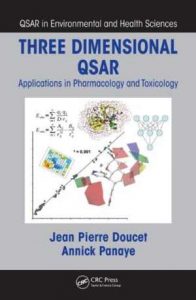نام کتاب: Three Dimensional Qsar – Applications In Pharmacology And Toxicology
نویسنده: Jean Pierre Doucet و Annick Panaye
ویرایش: ۱
سال انتشار: ۲۰۱۰
کد ISBN کتاب: ۱۴۲۰۰۹۱۱۵۸, ۹۷۸۱۴۲۰۰۹۱۱۵۱,
فرمت: PDF
تعداد صفحه: ۵۵۴
حجم کتاب: ۱۵ مگابایت
کیفیت کتاب: OCR
انتشارات: CRC Press
Description About Book Three Dimensional Qsar – Applications In Pharmacology And Toxicology From Amazon
As a result of new statistical and mathematical approaches, improved visualization tools, and recognition by international regulatory groups, quantitative structure-activity relationships (QSARs) now play important roles in pharmacology for the design of new drugs as well as in toxicology and ecotoxicology for hazard identification and risk assessment. Providing up-to-date coverage of the field, Three Dimensional QSAR: Applications in Pharmacology and Toxicology presents the most recent QSAR methods and illustrates their scope, advantages, and limitations. Part I The first part of the book addresses CoMFA and related methods, such as CoMSIA, FLUFF, SOMFA. It also describes shape-, surface-, and volume-based approaches, including MSA, excluded volume, LIV, HASL, receptor surface model, COMPASS, and CoMSA. Part II Focusing on methods that use 3D information, the second part covers autocorrelation methods, such as GRIND; similarity-based methods, including similarity matrices and quantum similarity indices; and quantitative spectroscopic data–activity relationships. Some applications in data mining are also explored. Part III The third part deals with post-3D models. The authors discuss the adaptation of the receptor and simultaneous presence of several conformers or solvation mechanisms. Part IV The final part presents receptor-related approaches as well as docking and free energy calculations, which are treated at various levels. This part concerns the extensive sampling of phase space and approximate methods, such as linear interaction energy, Poisson–Boltzmann, and generalized Born models. A case study covering several parallel approaches is also developed. An appendix offers the basic principles of modeling and statistical tools routinely required in QSAR methodologies, including optimization methods, molecular mechanics and dynamics, multivariate analysis, nonlinear models, and evolutionary techniques. It provides newcomers with the concepts necessary to fully grasp the essentials of these methods and gives a basic grounding in their correct use. Illustrated with numerous examples and a color insert, this book supplies a clear overview of the strengths and weaknesses of 3D-QSAR approaches. It explains how these modern techniques can link the biological activity of chemicals to their structure, encompassing both their 2D structural formulae and 3D geometry.
درباره کتاب Three Dimensional Qsar – Applications In Pharmacology And Toxicology ترجمه شده از گوگل
به عنوان یک نتیجه از رویکردهای جدید آماری و ریاضی ، ابزارهای تجسم بهبود یافته و شناسایی توسط گروه های نظارتی بین المللی ، روابط کمی فعالیت و فعالیت (QSAR) اکنون نقش مهمی در داروشناسی برای طراحی داروهای جدید و همچنین در سم شناسی و سموم زیست محیطی برای خطر دارد. شناسایی و ارزیابی ریسک. سه بعدی QSAR: برنامه های کاربردی در داروسازی و سم شناسی با ارائه پوشش به روز این زمینه ، جدیدترین روش های QSAR را ارائه می دهد و دامنه ، مزایا و محدودیت های آنها را نشان می دهد. قسمت اول قسمت اول کتاب به CoMFA و روشهای مربوطه مانند CoMSIA ، FLUFF ، SOMFA می پردازد. همچنین رویکردهای مبتنی بر شکل ، سطح و حجم ، از جمله MSA ، حجم مستثنی ، LIV ، HASL ، مدل سطح گیرنده ، COMPASS و CoMSA را توصیف می کند. قسمت دوم با تمرکز بر روشهایی که از اطلاعات سه بعدی استفاده می کنند ، قسمت دوم شامل روشهای همبستگی خودکار ، مانند GRIND است. روش های مبتنی بر شباهت ، از جمله ماتریس های تشابه و شاخص های تشابه کوانتومی ؛ و روابط داده – فعالیت طیف سنجی کمی – سایپرز ، باشگاه دانش برخی از برنامه های کاربردی در داده کاوی نیز مورد بررسی قرار می گیرند. قسمت سوم قسمت سوم به مدل های پس از ۳D می پردازد. نویسندهدر مورد سازگاری گیرنده و حضور همزمان چندین سازنده یا مکانیسم های حلال بحث می کنند. قسمت چهارم قسمت آخر روش های مربوط به گیرنده و همچنین محاسبه انرژی متصل و رایگان است که در سطوح مختلف تحت درمان قرار می گیرند. این بخش مربوط به نمونه برداری گسترده از فضای فاز و روش های تقریبی ، مانند انرژی برهم کنش خطی ، پواسون-بولتزمن و مدل های متولد شده عمومی است. یک مطالعه موردی شامل چندین رویکرد موازی نیز تدوین شده است. یک پیوست اصول اولیه مدل سازی و ابزارهای آماری را که به طور معمول در روش های QSAR مورد نیاز است ، شامل روش های بهینه سازی ، مکانیک مولکولی و دینامیک ، تحلیل چند متغیره ، مدل های غیرخطی و تکنیک های تکاملی ارائه می دهد. این مفاهیم تازه واردان را برای درک کامل موارد ضروری این روش ها در اختیار تازه واردان قرار می دهد و زمینه ای اساسی در استفاده صحیح آنها فراهم می کند. این کتاب که با مثالهای متعدد و یک درج رنگ نشان داده شده است ، یک نمای کلی از نقاط قوت و ضعف رویکردهای ۳D-QSAR را ارائه می دهد. این توضیح می دهد که چگونه این تکنیک های مدرن می توانند فعالیت بیولوژیکی مواد شیمیایی را به ساختار آنها پیوند دهند ، هم فرمول های ساختاری ۲D و هم هندسه سه بعدی را در بر می گیرند.
[box type=”info”]![]() جهت دسترسی به توضیحات این کتاب در Amazon اینجا کلیک کنید.
جهت دسترسی به توضیحات این کتاب در Amazon اینجا کلیک کنید.![]() در صورت خراب بودن لینک کتاب، در قسمت نظرات همین مطلب گزارش دهید.
در صورت خراب بودن لینک کتاب، در قسمت نظرات همین مطلب گزارش دهید.

